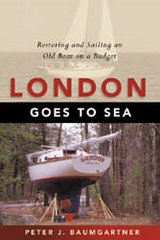Sailing with the Dictionary of AllusionsAfter twelve years of careful cruising, I am ready. This morning I will finally join that most exalted club of keel scrapers. I knew my time, my initiation, would come. It comes to us all. An unexpected grinding sound, a sudden lift, and you are in the club.
There are only three kinds of skippers: Those who have run aground, those who will run aground, and those that have but won't admit it. Sailing books and magazines are filled with information on how to get afloat after you have run aground, but I found a remarkable absence of literature on just how to drive your keel into something solid in the first place. Having now planted my keel firmly on a rocky ledge, I feel ready to share my insights.
While you may have your own special way of touching bottom, a manner of which you are particularly proud, what I am about to describe is a proven method, one that may help you get your hull up out of the water and onto that tempting shoal or ledge. Running aground can be a fairly long and difficult process. While sailing we are concerned with staying afloat, much as we are with the set of our sails. Both maximize boat speed. Dragging the keel across a hard surface has been shown to slow down the boat. It is something I was taught to avoid.
Underway, I try to keep a sharp eye on the depth meter, constantly cross-check my position with landmarks and reference buoys, and update my position on the chart at regular intervals. If you do all this, it can be fairly difficult, if not impossible, to run your boat aground. So what to do?
First, put yourself under some stress. It prepares you for making those final critical mistakes. You can build up that tension by pushing for a destination just at the limits of your range and energy, by being out in weather beyond your comfort level, or by carefully keeping your equipment poorly maintained. You will probably find that once you manage to get a few threads of tension going, others will arise as if of their own accord. Stress begets more stress.
When I dropped the anchor, I knew I would need to wake up during the night to check the depth of water under my keel. I am up nearly two hours before low tide. I stumble up onto the cold, dark deck and watch the electric red numbers of the depth finder. The digital display starts out at 5.6 feet but descends to 3.9 as beneath my bare shivering feet LONDON's hull swings slowly across the dark water in the tidal current. There is no time to be lost; there are rocks down there. I haul up the anchor, being careful not to drop the wet chain on my bare toes. The engine starts right up and I putt past the sleeping boats out into the harbor channel. It is so early. I try not to wake anyone else.
This brings us to another good way to get your boat roughly ashore. Sail in limited visibility. Dark and fog, or even better, both dark and fog, really improve your odds. And once you get underway in the dark or fog, don't worry. Be confident. You know what you are doing. You know where you are! I can't emphasize this enough. It is the critical belief. Let me repeat, You know where you are. It can be hard to read charts in the dark breezy cockpit. Don't bother. You have been through here before. It's fine.
I dimly watch a nun pass some distance to my starboard while I am heading for the lighthouse and out to sea. This does not bother me. I know where I am.
Do it at speed. Get the boat moving. I set all my sails full in a good breeze. All the running lights are on. I race along entranced by the beauty of the phosphorescent wake. I stand and watch my wake, almost mesmerized by it. Looking astern helps.
Finally, it is important to drive on. All situations—ledges, bars, and shoals—are different, but often the best thing you can do to make it a really solid landing is nothing. In my case, as the boat lurches and then begins to lift, I stand still in the cockpit, mouth agape, as the sails and wind pull the boat up higher onto the ledge. The rule here is, As you run aground, take no further action which might impede the grounding.
I experience a powerful sensation of wonder as the boat rises up out of the water and grinds to a stop. I have achieved the nearly impossible—driven my boat ashore while surrounded by modern navigation aids, charts, a couple of GPSs, and at least one compass. I am filled with feelings of disbelief and pride. I have attained a sailing milestone. I could almost grab the boathook and pat myself on the back. I am in the club.
What sirens lured me onto these rocks? Who sang that sweet song? The lovely melody of my own incompetence. I think about what I have done. My boat is up on Wood Islands rocky Negro Ledge.
I check below. The bilge is still dry. I try leaning out over the water on the lee shrouds. Nothing shifts. I am like Andromeda chained to her rock.
I turn on the deck lights and pace around the shores of my new island. To project myself somewhere else, I imagine how this looks from shore: a cone of white light shining down from high on a tilted mast onto a white deck askew, in the distance the lighthouse on the rocky island, and beyond that just the dimmest glow of deep blue above the dark line of the ocean horizon....



























